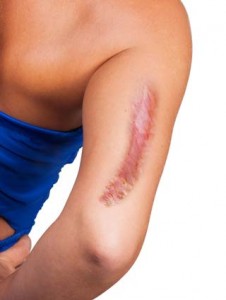
Chest and Shoulders
There are similar mechanical and biological differences in the skin around the chest, or sternum, and the deltoid, or upper arm and shoulder. According to the National Institutes of Health, these two areas have the worst results on the body when it comes to significant scarring. Why? Areas of tension tend to produce thicker and more noticeable scars.
Knees and Elbows
Like the shoulders and chest, knees and elbows are prone to heavy scarring. What makes these joints more difficult to heal with flat, pale scars, is that they are constantly stretched. This makes it harder for the skin to regenerate and heal. Scar tissue is tougher than regular skin tissue. It’s tighter and less pliable over joints, often causing constriction and limiting joint mobility. This can be painful and may require scar revision surgery if the effects are debilitating and severely limit mobility.
Ears
Like the deltoids and sternum, ears typically have thicker and more prominent scars. Red raised scars, called keloids, can be found on nearly any part of the body, but are particularly common after ear piercings. Keloids extend beyond the natural borders of the wound. They can be minimized with pressure earrings and topical keloid scar cream.
Legs
Skin on the legs is tighter and tougher than skin on many other parts of the body, which can cause scars to be thicker and more prominent. Leg scars are also more likely to be hypertrophic. Similar to keloids, hypertrophic scars are also red in appearance and rise above the surrounding surface of the skin. Unlike keloids, they seldom grow beyond the natural borders.
Intraoral Tissues
The inside of your mouth is the best healer when it comes to scars. Intraoral tissue stays moist and regenerates more quickly. It’s important to keep the area clean to avoid infection. Infection slows down scar formation and can create larger and thicker scars. Scarring inside the mouth is easier to conceal and causes less self-consciousness than scarring on the more visible exterior parts of the body.
Abdomen and Stomach
With little pressure on the belly, the abdomen and stomach tend to heal well with thinner, flatter scars. Surgical scars can be strategically placed below the bikini line or waistline, so they receive little sunlight and are rarely seen when you’re wearing everyday clothing.
Healing
There are many things that you can do to minimize the effects of scarring on any part of the body. Keep the wound moist and clean until it has healed. Seek healthcare from a medical professional for deep cuts or serious burns. If you have any type of surgery, follow your doctor’s advice for incision care. Avoid direct sunlight, which can cause hyperpigmentation, or bolder coloring. Silicone scar treatment is effective in reducing many types of scars, especially keloid and hypertrophic scars.
To learn more about Scarfade silicone scar gel, visit http://www.scarfade.com/faqs.html
